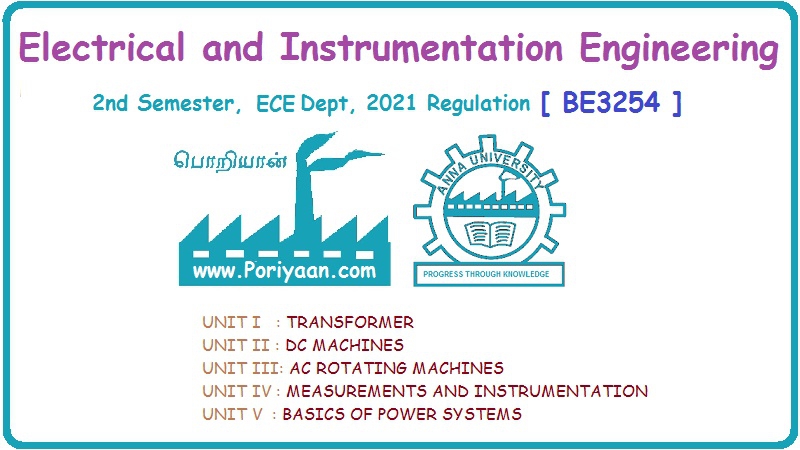Electrical and Instrumentation Engineering: Unit I: Transformer
Per Unit Representation of Transformer
Equivalent Circuit
Two winding transformer has primary and secondary winding. Therefore the p.u impedance deserves particular attention. (a) The approximate equivalent circuit of a two winding transformer with impedance referred to low voltage (primary) side. (b) The approximate equivalent circuit with impedance referred to high voltage (secondary) side.
PER UNIT REPRESENTATION OF TRANSFORMER
Two winding
transformer has primary and secondary winding. Therefore the p.u impedance
deserves particular attention.
(a) The
approximate equivalent circuit of a two winding transformer with impedance
referred to low voltage (primary) side.
Equivalent
circuit of a single phase transformer referred to LV side shown in Figure 1.21.


(b) The
approximate equivalent circuit with impedance referred to high voltage (secondary)
side.
The equivalent
circuit of a single phase transformer referred to HV side shown in Figure 1.22.



Mutual impedance
in pu between lines of different voltage level
Let us consider
two three phase lines of different voltage levels with mutual reactance Xm
present shown in Figure 1.23.

Transformer
always rated in KVA. Below are the two simple formulas to find the rating of
Single Phase and Three Phase Transformers.
Rating of a Single Phase Transformer in KVA
kVA = (V x 1)/1000
Rating of a Three Phase Transformer
Rating of a
Three Phase Transformer:
P= √3 V x 1
Rating of a Three Phase transformer in KVA
kVA = (√3 V x
1)/1000
Here is the rating of Transformer is
1000 kVA.
But Primary
Voltages or High Voltages (H.V) is 11000 V = 11 kV.
And Primary
Current on High Voltage side is 5.25 Amperes.
Also Secondary
voltages or Low Voltages (L.V) is 415 Volts.
And Secondary
Current (Current on Low voltages side) is 139.1 Amperes.
In simple words,
Transformer
rating in kVA = 100 kVA
Primary Voltages
= 11000 = 11kV
Primary Current
= 5.25 A
Secondary
Voltages = 415V
Secondary
Current = 139.1 Amperes
Now calculate
for the rating of transformer according to
P = V x 1
(Primary voltage x Primary current)
P = 11000V x
5.25A= 57,750 VA = 57.75 kVA
or P = V x 1
(Secondary voltages x Secondary current)
P = 415V x
139.1A = 57,726 VA = 57.72 kVA
Once again, we
noticed that the rating of Transformer (on Nameplate) is 100kVA but according to calculation... it comes about 57 kVA.
The difference
comes due to ignorance of that we used single phase formula instead of three
phase formula.
Now try with
this formula
P = √3 x V x 1
P = √3 V x 1
(Primary voltage x Primary current)
P = √3 x 11000 V
x 5.25A= 1.732 x 11000 V x 5.25A = 100,025
VA = 100 kVA
Or P = √3 x V x
1 (Secondary voltages x Secondary current)
P = √3 x 415V x
139.1A = 1.732 x 415V x 139.1A = 99,985
VA = 99.98 kVA
Consider the
(next) following example:
Voltage (Line to
line) = 208 V.
Current (Line
Current) = 139 A
Now rating of
the three phase transformer
P = √3 x V x 1
P = √3 x 208 x
139A = 1.732 x 208 × 139
P = 50077 VA = 50 kVA
Transformer
rating is expressed in kVA, not in kW. Rating of a transformer or any
electrical machine reflects its load carrying capability without overheating.
Temperature rise (major threat to insulation) arises due to internal loss
within the machine.
There are two
type of losses in a transformer;
i. Copper
Losses.
ii. Iron Losses
or Core Losses or Insulation Losses.
Copper Losses (I2R)
are variable losses which depends on
Current passing through transformer windings while Iron Losses or Core Losses or Insulation Losses depends on voltage.
So the
transformer is designed for rated voltage (iron loss) and rated current (copper
loss). We can't predict the power factor while designing the machine, because
power factor depends upon the load which varies time to time.
When a
manufacturer makes a transformer, UPS etc., they have no idea of the type of
load that will be used and consequently they can only rate the device according
to its maximum current output that
the conductors can safely carry (at unity Power Factor) and the insulation rating
of the conductors (voltage and temperature).
Electrical and Instrumentation Engineering: Unit I: Transformer : Tag: : Equivalent Circuit - Per Unit Representation of Transformer
Related Topics
Related Subjects
Electrical and Instrumentation Engineering
BE3254 - 2nd Semester - ECE Dept - 2021 Regulation | 2nd Semester ECE Dept 2021 Regulation
